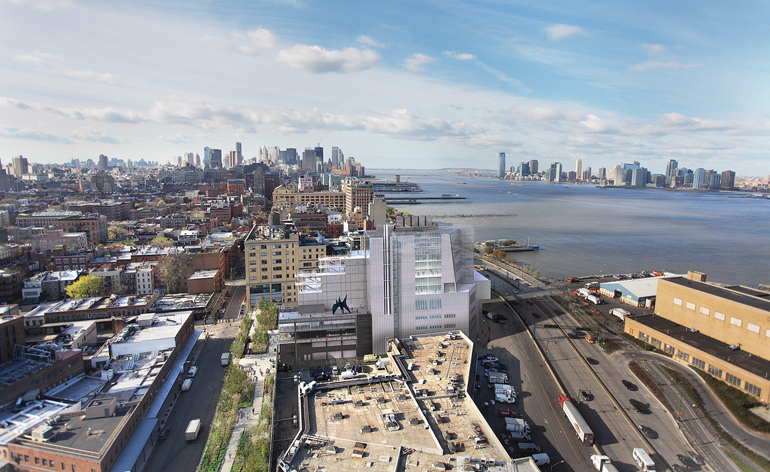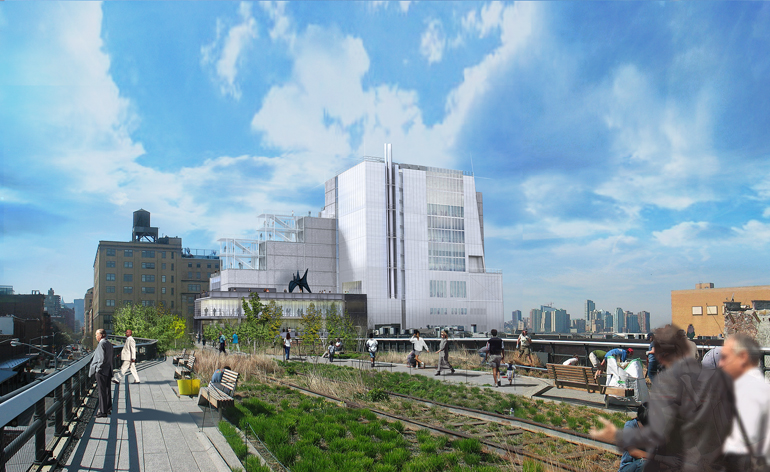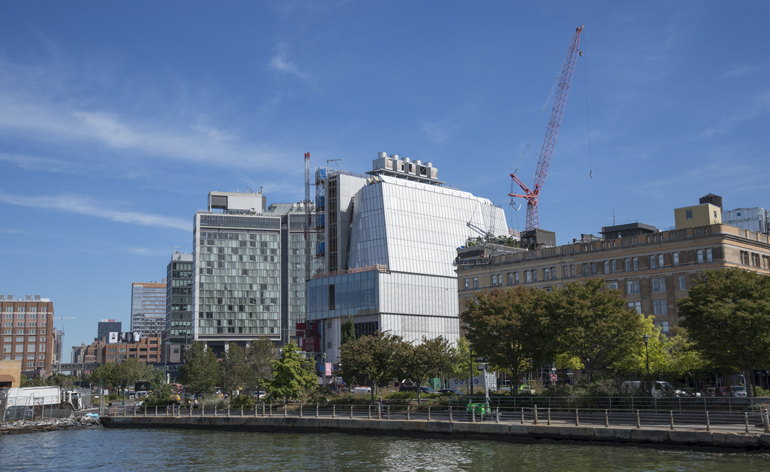Under Construction: The Whitney Museum's new HQ by Renzo Piano in New York

Construction is well underway on the new home for the Whitney Museum of American Art in New York's vibrant Meatpacking District. The new building, designed by Italian architect Renzo Piano, will become the museum's main base from spring 2015, when the whole collection will move from its existing HQ - the iconic, Marcel Breuer-designed building it has occupied since 1966 on Madison Avenue.
The new Whitney will offer 'unprecedented space for the museum's exhibitions and programs', say the institution's representatives. The structure spans 220,000sq ft and nine stories that will include the city's largest column-free art gallery spaces, an education centre, theatre, a conservation lab and a library and reading rooms. Two of the floors will be fully devoted to the Whitney's permanent collection (a vast 20,000 works).
In his design for the museum, the Pritzker Prize-winning architect put an emphasis on the outside spaces and the building's connection with the local community. Its strong, asymmetrical form generates a wealth of terraces, looking towards Manhattan, which will be used as outdoor galleries.
At the same time, the whole ground level will be glass-enclosed and visually transparent, to merge with its immediate surroundings and welcome in passers-by. A tilt upwards on the building's main volume on the ground level's ceiling was another strategic move to ensure the ground floor also gets plenty of natural light. 'We are creating an environment in which visitors will be encouraged to connect deeply with art through an irreplaceable first-hand experience', says Adam D, Weinberg, the museum's Alice Pratt Brown Director.
With construction more than half way complete at the new Whitney, plans have also been hatched for its old premises. The Breuer Building will be leased to the Metropolitan Museum of Art for a period of eight years, once the Whitney has moved to its new state-of-the-art home.

The new building will become the museum's main base from spring 2015. Building Workshop in collaboration with Cooper, Robertson & Partners

Seen here from the High Line, the new Whitney will offer unprecedented space for the museum's exhibitions and programs. Building Workshop in collaboration with Cooper, Robertson & Partners

The structure spans 220,000sq ft and nine stories that will include the city's largest column-free art gallery spaces, an education centre, theatre, a conservation lab and a library and reading rooms.

The new building's strong, asymmetrical form generates a wealth of terraces, looking towards Manhattan, which will be used as outdoor galleries.

The building's ground level will be glass-enclosed and visually transparent, to merge with its immediate surroundings and welcome in passers by.
Receive our daily digest of inspiration, escapism and design stories from around the world direct to your inbox.
Ellie Stathaki is the Architecture & Environment Director at Wallpaper*. She trained as an architect at the Aristotle University of Thessaloniki in Greece and studied architectural history at the Bartlett in London. Now an established journalist, she has been a member of the Wallpaper* team since 2006, visiting buildings across the globe and interviewing leading architects such as Tadao Ando and Rem Koolhaas. Ellie has also taken part in judging panels, moderated events, curated shows and contributed in books, such as The Contemporary House (Thames & Hudson, 2018), Glenn Sestig Architecture Diary (2020) and House London (2022).
-
 The new Tudor Ranger watches master perfectly executed simplicity
The new Tudor Ranger watches master perfectly executed simplicityThe Tudor Ranger watches look back to the 1960s for a clean and legible design
-
 This late-night hangout brings back 1970s glam to LA’s Sunset Boulevard
This late-night hangout brings back 1970s glam to LA’s Sunset BoulevardGalerie On Sunset is primed for strong drinks, shared plates, live music, and long nights
-
 How Memphis developed from an informal gathering of restless creatives into one of design's most influential movements
How Memphis developed from an informal gathering of restless creatives into one of design's most influential movementsEverything you want to know about Memphis Design, from its history to its leading figures to the pieces to know (and buy)
-
 Out of office: The Wallpaper* editors’ picks of the week
Out of office: The Wallpaper* editors’ picks of the week'Tis the season for eating and drinking, and the Wallpaper* team embraced it wholeheartedly this week. Elsewhere: the best spot in Milan for clothing repairs and outdoor swimming in December
-
 Nadia Lee Cohen distils a distant American memory into an unflinching new photo book
Nadia Lee Cohen distils a distant American memory into an unflinching new photo book‘Holy Ohio’ documents the British photographer and filmmaker’s personal journey as she reconnects with distant family and her earliest American memories
-
 Out of office: The Wallpaper* editors’ picks of the week
Out of office: The Wallpaper* editors’ picks of the weekIt’s been a week of escapism: daydreams of Ghana sparked by lively local projects, glimpses of Tokyo on nostalgic film rolls, and a charming foray into the heart of Christmas as the festive season kicks off in earnest
-
 Ed Ruscha’s foray into chocolate is sweet, smart and very American
Ed Ruscha’s foray into chocolate is sweet, smart and very AmericanArt and chocolate combine deliciously in ‘Made in California’, a project from the artist with andSons Chocolatiers
-
 Inside the work of photographer Seydou Keïta, who captured portraits across West Africa
Inside the work of photographer Seydou Keïta, who captured portraits across West Africa‘Seydou Keïta: A Tactile Lens’, an exhibition at the Brooklyn Museum, New York, celebrates the 20th-century photographer
-
 Out of office: The Wallpaper* editors’ picks of the week
Out of office: The Wallpaper* editors’ picks of the weekFrom sumo wrestling to Singaporean fare, medieval manuscripts to magnetic exhibitions, the Wallpaper* team have traversed the length and breadth of culture in the capital this week
-
 María Berrío creates fantastical worlds from Japanese-paper collages in New York
María Berrío creates fantastical worlds from Japanese-paper collages in New YorkNew York-based Colombian artist María Berrío explores a love of folklore and myth in delicate and colourful works on paper
-
 Out of office: the Wallpaper* editors’ picks of the week
Out of office: the Wallpaper* editors’ picks of the weekAs we approach Frieze, our editors have been trawling the capital's galleries. Elsewhere: a 'Wineglass' marathon, a must-see film, and a visit to a science museum